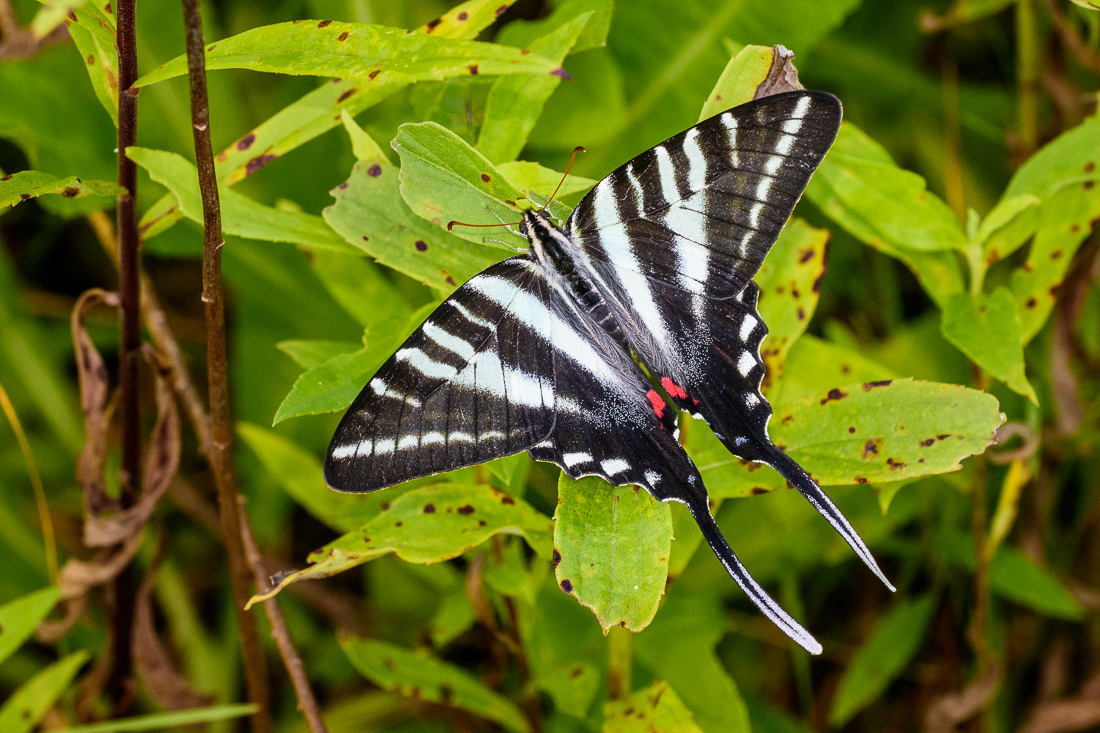

When ready, the caterpillars pupate under pawpaw leaves. These odors are synthesized from essential oils, called terpenes, in the host plant. Like some other swallowtail caterpillars, the Zebra Swallowtail caterpillar can fend off predators by pushing out its osmeterium, which is a yellow, forked organ that emits foul-smelling odors. When older, they still have the stripey rings, but are greener, and often have one thicker black band across the top of the first abdominal segment. When young, the caterpillar is dark with with many narrow transverse bands of black, yellow, and white. The Zebra Swallowtail larvae are hairless and appear somewhat humpbacked. The Zebra Swallowtail mamas might get a little help from a pyralid moth called the Asimina webworm moth, Omphalocera munroei, that eats older leaves of the pawpaw to encourage growth of new acetogenin-rich terminal leaves. Those young paw paw leaves and their stem bark are especially rich in acetogenins, chemicals that make the foliage unpalatable to browsers, like deer and rabbits, and the leaf-munching caterpillars distasteful to potential predators. The eggs are laid singly, one per leaf, because if the caterpillars encounter each other, they become cannibalistic. The Zebra Swallowtail female chooses young terminal leaves of the pawpaw on which to lay her eggs. The summer zebras are darker, with thicker black wing-stripes, and have longer tails than the ones that hatch early in spring. Along with the zebra-stripes of black and greenish-white, the Zebra Swallowtail has two blue spots at the base of the upper surface of the hindwing, another bright red spot close to the body, and a red median stripe on the underside of the hindwing. Its wings are more triangular in shape (with a span ranging from 2.5 to 4 inches) and its “tails” are longer and more slender than those of our other native swallowtails. Wind gusts from an approaching storm were keeping it grounded, which gave me ample time to admire and study its bold coloring. The first time I saw a Zebra Swallowtail, it was clinging with wings broadly spread, to a piece of tall grass at the edge of a cluster of pawpaw trees. It happens that the Common Pawpaw, Asimina triloba, from the same family (Annonaceae) as the tropical custard apple and cherimoya, is also the only of the Asimina genus that is able to grow in this region of temperate North America, suggesting that the Zebra Swallowtails and the pawpaws have been co-evolving here since this region was very different than it is today. The sole source of food for the Zebra Swallowtail's caterpillars is the foliage, particularly the young leaves, of trees in the genus Asimina, the pawpaws. Other species from this genus live in subtropical zones. The Zebra Swallowtail, Eurytides marcellus, is the only species of the genus Eurytides (the kite swallowtails) that makes its home in the temperate zones of North America.
#Bamona zebra swallowtail Patch
If you see one of these distinctive long-tailed butterflies glide past, it's likely there's a pawpaw patch nearby. As we obtain more photographs, we will add them here.The Zebra Swallowtail butterfly and the Common Pawpaw tree have been through a lot together. Our preference is to use photographs taken in AL/MS, but occasionally photos will be from outside the two states. Each species page will contain photos and a distribution map indicating the counties within Alabama and Mississippi where the butterfly has been documented as occurring. If we have photos for a particular species, then there will be a link from its common name to the species page. The Alabama list is based upon the work of Vitaly Charny and the Alabama Butterfly Atlas the Mississippi list is taken directly from the BAMONA (Butterflies and Moths of North America) website. The species known to occur in AL/MS are listed below.

Because of our passion for identification, we also provide as many field markings as possible to aid in identification.

It is the goal of these pages to introduce you to the abundance and diversity of the butterfly fauna of Alabama & Mississippi, through photographs of adults, eggs, caterpillars, chrysalids, and host plants. The states of Alabama and Mississippi are home to over 150 species of butterflies and skippers.


 0 kommentar(er)
0 kommentar(er)
